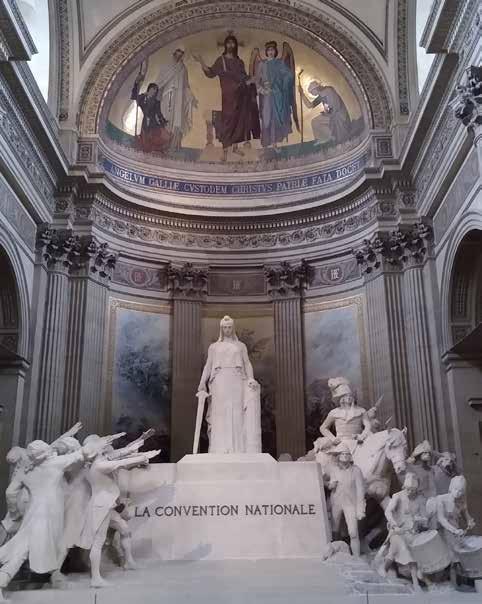
17 minute read
School Visits
Religious Studies
Year 11 visit the Milton Keynes Peace Pagoda
Advertisement
The Year 11 trip to the Nipponzan Peace Pagoda in Milton Keynes and the Amaravati Buddhist Monastery in Hemel Hempstead was an excellent way to indulge in our study of Buddhism, a key part of the GCSE course.
We arrived at the Peace Pagoda first, greeted with a fine piece of architecture which looked to be straight from Japan. The reason behind this turned out to be because it was originally built under the supervision of monk Nichidatsu Fujii, who aimed to spread world peace and unity. We soon explored the surrounding area including the Peace Pagoda, which had the story of the Buddha sculpted onto it.
The relevance of each image around the Pagoda was well explained by Mr Warner and Mrs Crussell, as it helped broaden my understanding of the Buddha’s life. After taking time for a lunch break, we headed to the Amaravati Buddhist Monastery. We were met with a warm welcome, as the monk who showed us around was very endearing. Shortly after greeting him, we were taken to the meditation room. Immediately the overwhelming sense of serenity and peace hit us, as the silence of the meditation gave the room a feel of tranquillity.
The monk happily obliged with all the questions we asked him, including detailed questions of what it’s like to be a Buddhist monk. He showed us around the Monastery before ending the tour with a small meditation workshop which helped clear our minds and let the day’s events settle in. All in all, the trip to the two sites was an excellent experience provided by the school and really helped build on my knowledge of the Buddhist religion.
Lakshya Verma – Hampden 11
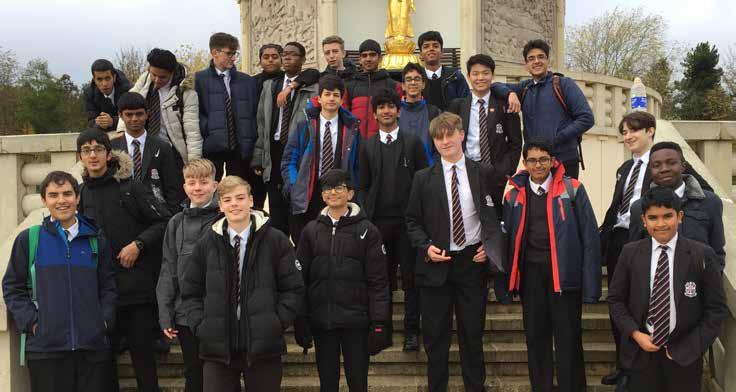
Business & Economics Year 13
visit to Brussels
A slightly bleary-eyed group of 16 Year 13s met Miss Chalk and Mr Davey at Aylesbury train station early on a Sunday
morning in October. We caught
the train through to St Pancras from where we took the Eurostar from St Pancras to Brussels. The journey from Aylesbury to the hotel took a total of 6.5 hours and after a quick break in our rooms at “Meininger”, we had an evening walk to and around the medieval square “Grand Place”. This was also where we had our evening meal, at the Hard Rock Cafe.
The next day, after a good night’s sleep and a buffet breakfast, we walked to the National Bank of Belgium Museum via the landmark “Manneken-Pis”. Whilst at the museum we heard a talk about how the Euro currency is printed and distributed, along with an explanation of the role played by the Eurozone. After this we caught a public bus and visited the artisan “Concept Chocolate”. Here we participated in a twohour workshop; using a variety of types of chocolates and toppings we all made a random selection of chocolates. This trip gave us an understanding of how an independent business works in an international market and was very interesting. The visit concluded with the opportunity to make some delicious purchases from their gift shop to take home. Our evening meal was at Chez Leon, a popular Belgian restaurant.
On Tuesday we had an early start to visit the Coca Cola Visitor Centre, just outside Antwerp. Here we heard how the company conducts market research and we were given a tour of the factory to understand the production process. Later in the afternoon, we took a trip to the European Parliament to visit the Hemicycle and listened to a Civil Servant explain how the EU works. Our day finished with an evening meal at the Old Wild West restaurant in the centre of Brussels.
Our last morning in Brussels was spent walking around for some lastminute shopping, before catching the Eurostar train back to St Pancras. The connections worked well, even managing to get through rush hour in London on the tube with such a large group with luggage and we were all home early evening. Many thanks to Miss Chalk for organising this trip, it was a great experience.


Geography
Year 10 visit to the Lake District
Fieldwork is an important part of Geography. Much of what we know about the world around us is because at some point a Geographer has gone outdoors
and measured it. The skills of
planning an investigation, accurate observation and measurement, and careful evaluation are important ones that we develop at AGS from Year 7’s study of coasts and their trip to Southend-on-Sea up to A-level study where, with pleasing symmetry, we visit the coast again at Barton-onSea. At GCSE we visit the Lake District National Park in Year 10 for three days for the pupils to practice their fieldwork skills ahead of the exam on Geographical Applications in Year 11.
Leaving Turnfurlong at 0600 on a Monday in early March, we headed through morning traffic to the M40 where we would drive north-west to Birmingham. Birmingham’s industrial history and one million inhabitants make it a perfect case study for our learning of urban environments.
Arriving to Birmingham’s Centenary Square we admired the bold new Library of Birmingham building, the Repertory Theatre and the International Convention Centre. This area of the city is presently overlooked by a building site as more steel and glass office buildings are constructed. The pupils here were investigating the opinions that local residents have regarding the regeneration of the city. They spent time as we walked asking questionnaires that they had designed in class to the pedestrians we passed as well as completing their own environmental surveys of the area.
Our route wound its way along the canals and headed into the centre of Birmingham passing through the Mailbox shopping centre, the impressive redevelopment of the New Street Station and the historical Rag Market before stopping for lunch at The Bullring. The boys always enjoy exploring the Bullring over their lunch break and the Five Guys restaurant is usually very popular.
After lunch we made our way through Birmingham University campus towards Curzon Street Station. This is where HS2 is planned to stop when it is built and there are lots of billboards with information on for the boys to see. It is here that we re-joined the coach and continued our trip north to the Lake District.
The Lake District is a perfect location for completing fieldwork on a range of our GCSE topics. During our time there, the boys complete investigations into rivers, glaciated landscapes, tourism and footpath erosion.
Upon arriving late afternoon, the boys are straight out into Grasmere completing surveys on tourism and asking more questionnaires to locals and tourists. For the tourism investigation each group of three or four boys had planned a number of their own surveys to complete in Grasmere. Their aim is to find out whether tourism negatively affects the town of Grasmere and many groups end up focusing on how tourism may impact the environment and what local people think about the thousands of tourists who visit each year. Grasmere is a popular tourist destination in the Lake District as the home to the Wordsworth Museum, the Allan Bank National Trust property, and the world-famous Grasmere Gingerbread shop so there are plenty of people

to interview even on a Monday evening in March. After a busy first day the boys all retired to Grasmere Butharlyp Youth Hostel for their evening meal and base for the rest of the trip.
Day two started early to a hearty cooked breakfast at the youth hostel. The running order of this trip is often prescribed by the weather and the Lake District’s famously changeable conditions. Mr Corby, Mr Travers, Mr Walker and I spent much of the previous evening pouring over the MET office website and looking at weather forecasts. We decided that we would climb up to Easedale Tarn to complete our glacial environment study in the afternoon leaving the morning to head out into Grasmere to collect more data. Leaving Grasmere late morning we were grateful for a break in the rain however there was lots of evidence of the heavy downpours from the previous few days as the path and river channel shared the same space. Many of the boys had brought their wellies for the river investigation however they certainly came in useful on the saturated path.
Easedale Tarn was formed in the last glacial period when the Lake District as well as much of the rest of the UK was covered in ice. Glacial deposition sediment has its own unique characteristics which the groups were looking to investigate. As we ascended the valley we passed the waterfall of Sour Milk Gill. The wind was beginning to build here and water was whipped up into the air. The wet weather of the previous few weeks meant that the waterfall was particularly spectacular. The wind at the top of the path was severe and each teacher picked a different hollow to shelter in with their class to brief them on the task ahead. Brief glances into the biting wind to look up at the vertical cliffs of the corrie were mixed with sheltering and holding down hoods to stop them blowing down. The boys hastily took their notes and observations before retreating back down the footpath. On the return trip, each group explored the impact that walkers have on the area by measuring footpath erosion. Returning back to Grasmere many of the groups took shelter into one of the cafes for a hot drink and some cake before heading back out to continue their tourism surveys. The second night at the hostel is always quieter than the first.
The final day, following another cooked breakfast, we headed out to the river of Little Tongue Gill to complete our river investigation. The classes split to three locations along the river and, using the flowmeters, stopwatches and an orange, each group worked out the average velocity of the stretch of river that they had been allocated. The use of two different methods for measuring velocity gives the pupils an opportunity to compare their results and evaluate their data collection. The rain began to set in and we decided to head back a little earlier than planned, arranging to meet the coach at the bottom of the trail for our return journey to Aylesbury.
The Year 10 Geography Lake District Trip is certainly a very busy three days for pupils and staff. It is a valuable opportunity to learn about fieldwork skills as part of the Geography course and to see one of the most beautiful parts of the British countryside. As the organiser of the trip I would like to take this opportunity to thank all of the pupils who went to Grasmere this year as they worked incredibly hard in some inclement weather conditions and each of the Geography teachers very much enjoyed teaching them over the three days. I would also like to thank Mr Walker for joining us as without staff volunteering their time, trips like this would not be possible.
Mr M Jones

Spanish
Year 12 visit to Madrid
The Spanish trip to Madrid in late February started with an outrageously early morning meet of 3:30am, in order to catch what can only be assumed was an accidentally booked 7:35
A.M flight from Heathrow. A
seamless coach trip and flight saw us touchdown in Madrid by the early afternoon. We began to familiarise ourselves with Madrid on the drive to the hostel, and the subsequent walk from where the coach was parked introduced us to the various quirks of Madrid. Streets in the city centre were almost entirely void of cars, and men dressed as cartoon characters were oddly common. We then found and settled into our hostel, before embarking on a walking tour of some of the city, where we stopped off at various important historical and cultural spots. Having been awake for the best part of 20 hours, we were grateful to catch some sleep after a bottomless buffet at FrescCo.
The following day we had another early start, to visit Real Madrid’s home stadium, a fascinating trip for anyone interested in football. The changing rooms were open to have a look into, and we could walk down the tunnel onto the side-line of the pitch as well. After this, we went to a very different but equally interesting tourist venue, El Valle de los Caídos. The overwhelming size and haunting style of this civil war monument had a great effect on a lot of us and it was strange to see flowers lain on the graves of some of the men involved in Franco’s dictatorship of the 20th century. The final site of the day was El Escorial, an incredible building designed to resemble a grill from above, in honour of Saint Lawrence who was martyred by being roasted on one in the 3rd century. It houses art and books as well as tombs of the majority of Spain’s monarchs from the past few hundred years.
The last full day in Madrid began with a trip to Reina Sofia Museum. This enormous collection of buildings celebrates some of the greatest artists ever, both Spanish and international. Picasso and Dalí were well represented, including Picasso’s infamous ‘Guernica’ which, despite the pleas of Mrs Corbould, Mrs Burnett and Mr O’Driscoll, many of us didn’t quite understand. After a bit of tapas for lunch, it was off to the Retiro Park, a vast, 350acre national park, populated by sculptures and monuments, as well as an incredible lake. We finished the day’s sightseeing with a trip to the Prado Museum, which is widely considered to house one of the finest collections of European art, including highlights by El Greco and Diego Valázquez. We managed to enjoy the over 10,000 pieces of art despite the tiring day which had preceded it. After a final trip to FrescCo and a visit to San Ginés for some churros, we headed back to the hostel to pack and sleep, in preparation for a day of travelling back home the next day. A huge thank you is owed to Mrs Corbould, Mr O’Driscoll and Mrs Burnett for perfectly organising the trip and guiding us through the various tourist attractions we went to. We hope that another Spanish Trip will be possible in 2021.
Albie Whittemore – Paterson 12
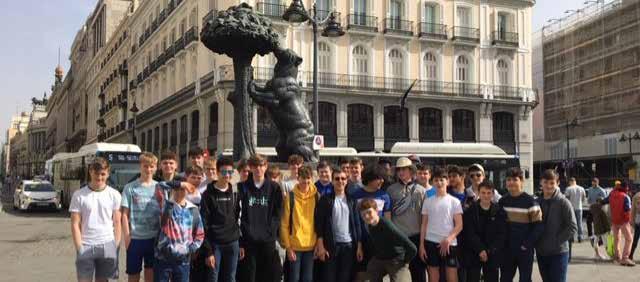

Spanish
Year 9 visit to Barcelona
This exciting excursion to the beautiful city of Barcelona began in the early hours. Nevertheless, excitement was in the air for what Barcelona had in store
for us. We arrived in Spain in the afternoon and travelled by bus to our hotel, which was in the town of Salou – a picturesque coastal town about an hour from Barcelona.
After we had settled into our hotel rooms, we explored the centre of Salou. There were many shops selling a variety of souvenirs, from football shirts to fridge magnets. Some of us ventured to the cafés to try the local cuisine, which naturally meant delicious churros and Fanta Limon. Later that evening we made use of the games room, especially the pool tables.
The second day started with a visit to Camp Nou (the F.C Barcelona stadium). We saw where the press watches the Barcelona games, at the very top of the stadium looking down onto the pitch. The view of the stadium from this room was breathtaking, as we could see most of the 99,000 seats that looked down on the perfectly cut pitch. After that we continued our tour through the away changing rooms, which had an abundance of facilities for the players – including massage beds, a hot tub and even a chapel – as well as the press conference room, and the FCB museum – which had all sorts of trivia about the club and many of their awards and trophies on display. Next, we visited the huge gift shop that had two whole floors full of every type of Barcelona merchandise you could dream of.
After that, we visited the unfinished Sagrada Familia. In my opinion, the Sagrada Familia is an example of the most magnificent architecture in Europe. The sheer size of the building is astonishing, but the intricacies of the architecture are not lost in the magnitude. The ornate designs of the building are extraordinary; however, the building was still in construction when the designer, Gaudi, died. He did not leave any plans behind in this world, and so architects have been debating for the best part of a century on how to finish the building. You would think that it would be a simple task, as one could just finish the building by continuing the patterns. However, Gaudi’s architecture was unconventionally irregular, making the decision to finalise the design even more difficult.
The third day began with a continuation of the theme of architecture; we saw two blocks of flats designed by Gaudi. They stood out from the rest of the street, totally unique, adding culture and life to the streets where the other buildings stood in uniformity.
After we had appreciated the architecture, we visited the Plaza de Catalunya, where we ate authentic tapas. The food in the tapas restaurant was delicious, particularly the homemade patatas bravas. Then we walked up and down Las Ramblas, which was full of interesting shops and street stalls. Following the visit to Las Ramblas, we went to the top of Montjuïc, which gave us a brilliant view of the city and the sea.

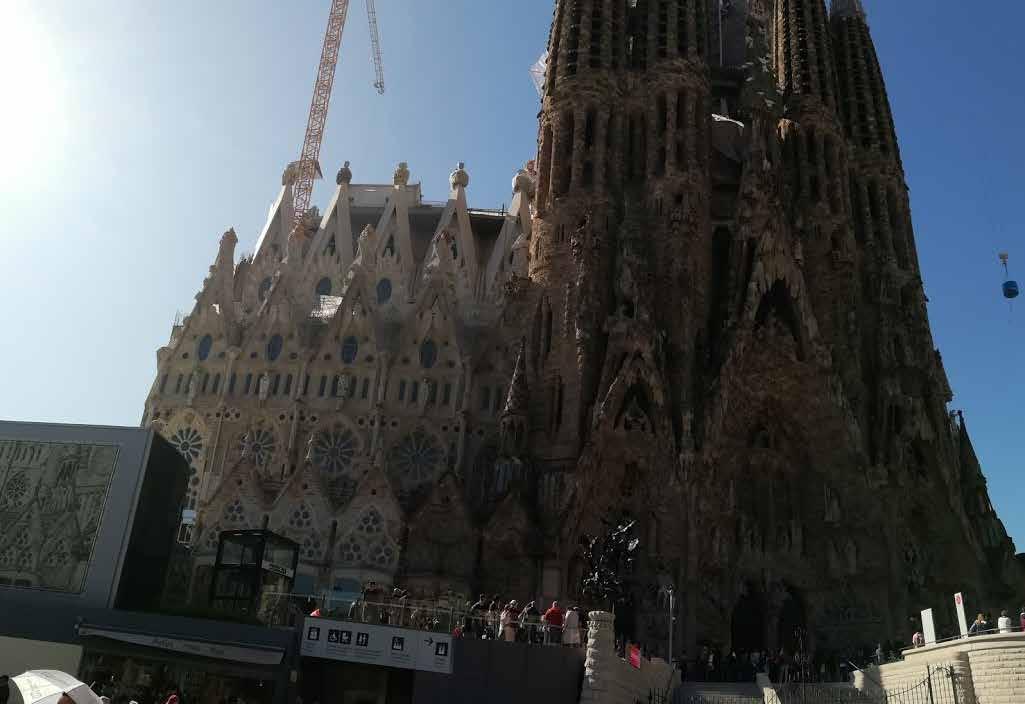
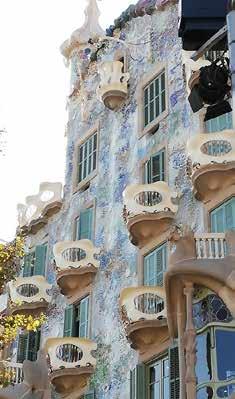
Then came the eagerly anticipated visit to PortAventura. PortAventura is Catalunya’s equivalent of Thorpe Park, the adrenaline addict’s paradise, the thrill-seeker’s nirvana. We split up into groups and rode the most exhilarating rides Spain has to offer: the breathtaking Furious Baco, the rattling Stampida, the ridiculously towering Hurakan Condor and the perimeterstretching Shambhala. Every type of rollercoaster was at PortAventura, and it was apparent on the bus journey back that everyone enjoyed their time at the theme park. On the last day we ventured into Salou one last time to look around the shops and make the most of our opportunities to converse with the locals.
Overall, we were able to improve our Spanish, learn about the culture first hand – particularly the Catalonian independence movement, which had its logo graffitied all over the city – and most importantly, had an amazing time.
On behalf of all of us that went, I would like to thank all the teachers that made this brilliant trip possible: Mr O’Driscoll, Ms Treherne, Mr Walker, Mrs Lillywhite, Mrs Corbould and Mr Jones.
George Mansfield – Paterson 9
French
Year 13 visit to Paris
An early start was necessary to catch the Eurostar from St Pancras on the morning of 4th October, as students from AGS and AHS embarked on a cultural
voyage. After a tense coach journey that included heavy traffic and travel sickness (naming no names), we made it and were able to recuperate and relax on the Eurostar, before heading to our accommodation.
Some of the excursions during the trip included visits to the Musée d’Orsay, the famous Arc de Triomphe, the Palais de la Porte Dorée, Hôtel des Invalides as well as the fascinating and alternative play ‘La Cantatrice Chauve’. We also successfully navigated the Metro and tram network of Paris, which can often be daunting to tourists. Official highlights include waving at river cruise passengers, charging at the train barriers, Louis being scammed on the metro, Raouf toppling an exhibit and lots of singing.
Many thanks to Mr Crapper for organising and leading an unforgettable trip.
Sam Bunker – Denson 13
